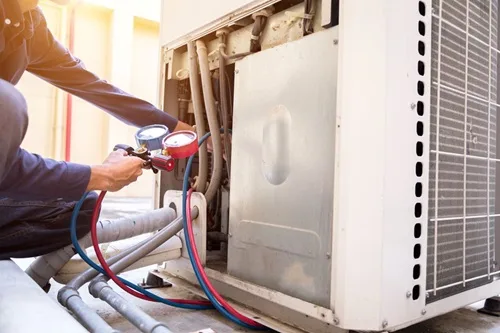As summer draws to a close, it becomes the perfect opportunity to conduct a detailed assessment of your heating, ventilation, and air conditioning (HVAC) systems. Inefficiencies in these systems, often overlooked, can lead to unnecessarily high energy bills. A comprehensive inspection is particularly important now, following months of intensive use during the warmer weather, to ensure everything is functioning efficiently. The checklist below offers guidance on how to approach this essential maintenance.
Plan your HVAC tune-up at the end of summer.
Experts recommend regularly checking HVAC systems after each season. Especially in summer, the systems are often pushed to their limits. This also increases wear and tear and the risk of potential damage. Therefore, schedule your end-of-summer HVAC tune-up well in advance and create a sufficient time window. If you don’t know how to check yourself, what you need to replace and so on, contact HVAC professionals. Look over their shoulders as they carry out their work so that you are better prepared for the next time. The task checklist helps to ensure that nothing is forgotten during maintenance:
Inspect and maintain filters
A clean filter system is the centrepiece of an efficient HVAC system. Check the filters for dirt and debris. Clogged filters reduce airflow and force your system to work harder, increasing energy consumption. Replace heavily soiled filters immediately to improve air quality and increase efficiency. Filters should be changed at least every three months, or more frequently if they are heavily used.
Tip: A significant proportion of the world’s population suffers from allergies. It is estimated that 30-40% of the world’s population is affected by one or more allergic diseases. Many of them notice symptoms such as sneezing, watery eyes, etc., especially at home due to house dust or pollen. During the summer months, a particularly large amount of residue collects in the filters of HVAC systems. It is therefore essential to change the filters before autumn in order to improve the air quality.
Evaluating coolant levels and condensate lines
The coolant level is crucial for cooling your rooms. If the level is too low, this may indicate a leak that needs to be repaired immediately. A specialist can check the coolant level and rectify any leaks. You should also inspect the condensate pipes. Blockages can lead to water damage if the condensate builds up. Make sure that the pipes are clean and free of deposits.
Checking thermostat settings
Make sure your thermostat is set correctly. A programmable thermostat can be particularly useful here to adjust the heating and cooling times to suit your lifestyle and save energy when no one is at home. Check the settings and adjust them to the cooler evening temperatures.
Inspecting the seal of the ventilation ducts
Ensuring that ventilation ducts are tightly sealed is crucial for maintaining the efficiency of your heating and air conditioning systems. Up to 20 per cent of treated air can be lost through leaky ducts before it ever reaches the intended spaces within a building. A meticulous inspection should be carried out to check for any cracks, holes, or loose connections in the ductwork. Leaks often occur at points where ducts have been installed or previously repaired. Over time, natural deterioration of materials or physical damage from external factors can also result in leaks.
Visual inspection of the HVAC system
Go through all visible parts of your HVAC system. Pay particular attention to corrosion, loose connections or other signs of wear. Clean leaves, dirt and other debris from the outdoor units to improve air circulation and maintain efficiency.
Replace worn parts
Pay attention to the lifespan of the individual components of your system. Parts such as the condenser, evaporator and other mechanical components may show signs of wear. If these parts show signs of wear or their functionality decreases, they should be replaced to ensure optimum performance.
Energy savings through regular system maintenance
About 30 % of electricity in residential buildings is consumed by HVAC systems. Errors during installation and maintenance can unnecessarily increase consumption. Research results such as those from NIST show that installation errors can significantly reduce energy efficiency. Leaking ducts and incorrect refrigerant charges are just two examples that can lead to overuse of systems. By rectifying such defects, you can significantly reduce your energy bill. A regular check ensures that your system is running optimally and does not incur any hidden costs. Annual maintenance will save you money in the long term and increase comfort in your home.
Optimising power generation for even greater savings success
In addition to regular maintenance of your HVAC systems, you can further increase your energy efficiency and reduce electricity costs by investing in solar technology. Installing solar panels on your roof is an effective way to generate electricity sustainably and reduce the consumption of grid electricity.
Solar cells convert sunlight directly into electricity, which can then be used to power your heating, ventilation and air conditioning systems. This is done using photovoltaic panels installed on your roof or other suitable locations. The electricity generated in this way is either used directly, stored or fed into the public grid, for which you may receive compensation.

